By Chuck Trefts,
North America General Manager, Ellisys.
On a recent sunny day, I decided I’d try to enjoy the afternoon in my backyard with a cold beverage and a little music. I connected my phone to my AV receiver over Bluetooth and began to stream my favorite tunes from my Wi-Fi.
As the music played from the AV receiver through the wired backyard speakers, rather than just relax and enjoy the nice weather like a normal person, I began to ponder the simplicity of the user experience here: grab my phone, open my music application, and play some music. Easy. This pleasant experience illustrates the promise of modern wireless technologies – to make our lives simpler, more enjoyable, and easier in so many ways.
As a wireless test solutions provider, we know these technologies are not at all simple in how they work “under the hood.” I started to think about my humble home wireless environment. I could see the microwave oven was operating, my 2.4GHz security cameras were running here and there, of course there was the Wi-Fi exchanging data amongst a variety of equipment such as TVs, my phone, my watch, the air conditioning controllers, two or three mobile phones, a door access system, even the washer and dryer were connected.
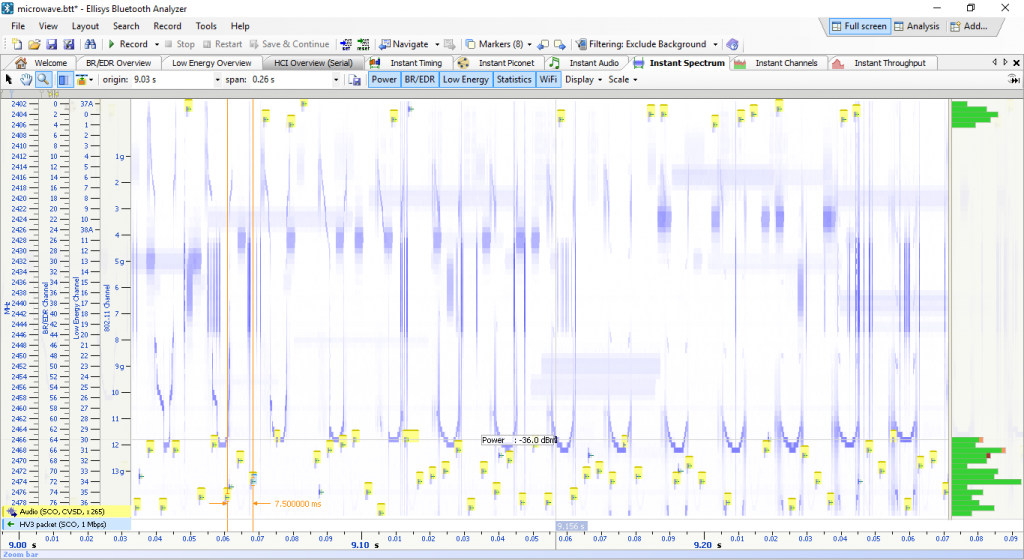
Here, the devices under test avoid the middle of the spectrum (as evidenced by the stacked bar statistics at right) where a microwave oven is emitting (the semi-sinusoidal waveform).
I tried to add them all up, but started to lose count, so I opened my service provider’s handy application to see just what was happening in terms of the number of Wi-Fi devices operating. This indicated 13 active devices operating in the 2.4GHz band, with another 16 present, but not currently active. Wow. Between all these Wi-Fi devices, various Bluetooth connections, some alarm system devices operating using Zigbee, the security cameras running some sort of proprietary 2.4GHz protocol, and the microwave oven, I had a lot of wireless traffic flying around. Wi-Fi from the neighbors was everywhere as well.
So, why was my music playing so flawlessly in this crazy swamp of RF energy? There were no pops, gaps, nothing, just perfect audio over a pretty good range of about 10 meters. Wi-Fi works in the 2.4GHz ISM band, Zigbee and other 802.15.4 technologies play there too, as does Bluetooth of course. A microwave oven chaotically bleeds energy all over the same RF playing field where all these technologies are trying to communicate. Quite a crowded place for my music-filled Bluetooth packets to navigate indeed. But navigate they do. How?
Well, let’s start with the basic principle that receivers work more reliably when the air is not cluttered with electromagnetic energy that is extraneous and effectively competitive to the stream of interest, in my case those Bluetooth packets with my awesome music inside. How well a device performs to its given function in a shared physical environment (such as the unlicensed ISM 2.4 band) and how a given device may adversely affect other devices operating in or near that shared spectrum is basically the definition of coexistence, or co-ex for short. There are more sophisticated definitions, but this should work for our purposes here.
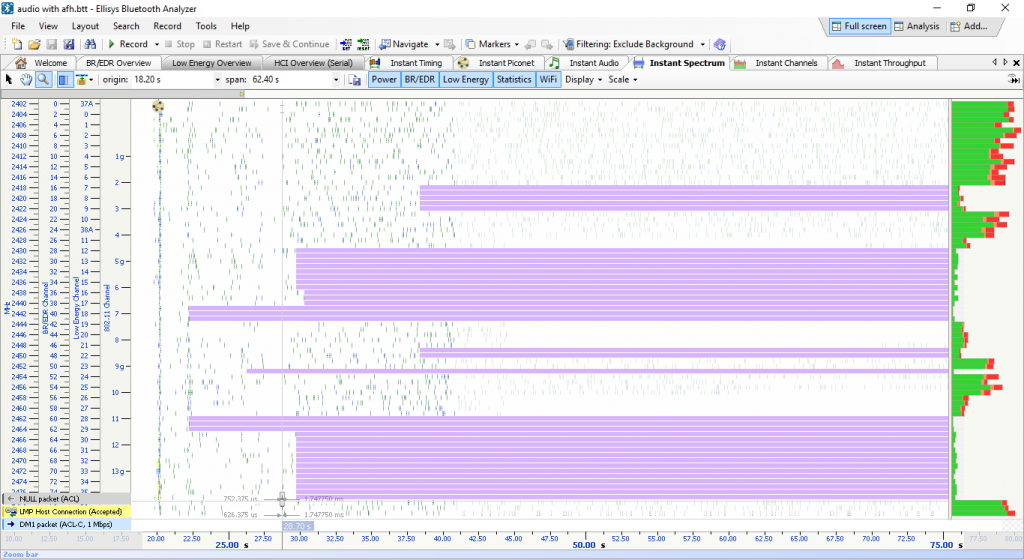
Bluetooth devices can improve communications by avoiding busy channels where the spectrum is crowded.
Co-ex issues are a rather common cause of performance degradation with wireless devices. These issues can add to overall power consumption, as retransmitting lost packets consumes additional energy. There can be hits on device responsiveness, decreased range, audio quality impacts, connection difficulties, and other undesirable effects on the user experience.
Many of our larger customers have entire teams of specialists dedicated to characterizing the quality and performance of their products in a variety of challenging RF conditions. These teams often test under busy wireless conditions intentionally crafted to be stressful. Other customers may not have such a central focus on co-ex, but nevertheless they are always unintentionally subject to the challenges presented by other emitters intersecting on time and frequency domains. Being able to recognize and characterize co-ex effects using Ellisys tools is key to minimizing troublesome (and costly) detours along the design pathway.
Co-ex issues can arise from “uncoordinated” devices that just happen to be near each other, or from “coordinated” devices, such as co-located radios on a combo chip or co-resident on a product. The most common form is the uncoordinated kind – such as your phone’s connection to your earbuds as may be affected by some random Wi-Fi access point you happen to pass.
Products with co-located radios or multi-radio combo chips can employ inter-radio coordination schemes and channel-skipping to better coordinate which co-located wireless technology talks, when they talk, and where they talk (on which portions of the available band), thus improving the performance of all participating radios. When everybody talks at once, it’s hard to hear anyone, so to speak. Because of the proximity, co-ex issues arising from co-located radios can be quite severe if not managed properly.
Bluetooth has more ways to minimize the impact of co-ex issues on device performance than one might realize. Probably the simplest such defense is the frequency hopping spread spectrum (FHSS) approach Bluetooth employs. This pseudo-random hopping sequence ensures Bluetooth transmissions don’t “dwell” on specific frequencies, as is done with several other wireless technologies. Put simply, FHSS takes a narrowband signal and spreads it across a wide band (up to 80MHz in the case of Bluetooth). In addition to helping to combat interferences, this technique also helps with channel fading.
Adaptive Frequency Hopping (AFH) is another important mechanism and probably one of the better-known defensive features available to Bluetooth developers. This scheme periodically enables and disables Bluetooth channels to avoid areas in the spectrum that are deemed as problematic for Bluetooth communications. This feature is quite dynamic; the adaptations can quickly react to changing RF conditions. AFH behaviors can be driven locally by a device’s controller, using channel assessment techniques, through link layer commands between the communicating devices, or via commands over the host-controller interface (HCI) from the host software stack, which may be working with the device’s Wi-Fi radio to coordinate shared access to the medium.
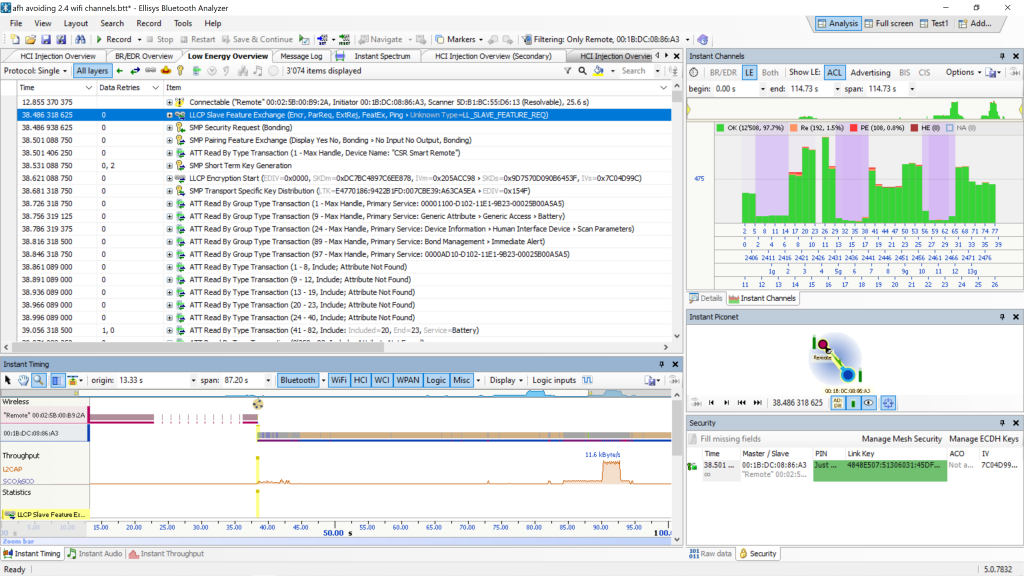
Here you can see a typical Bluetooth capture, with all traffic filtered out except traffic between two devices. The Channels view at top-right indicates a very good rate of good packets (by channel and overall), a low rate of retransmissions and errors, with most of the avoidance is centered on non-overlapping Wi-Fi channels.
The Bluetooth specification does not provide a standard co-ex interface with Wi-Fi, but there are many techniques available to do this, including proprietary approaches. One such technique is Packet Traffic Arbitration (PTA). PTA, a collaborative technique, is a recommendation, not a requirement, and is based on an IEEE specification released many years ago. Many PTA schemes have proprietary tweaks that idealize behaviors for specific manufacturers. PTA coordinates the sharing of the available spectrum between co-located devices (e.g., Bluetooth and Wi-Fi) and uses anywhere from a simple one-wire approach to four or five wires, depending on the needs and capabilities desired by the designer. In some cases, the physical PTA lines can be accessed by test equipment, such as the logic inputs on the Ellisys suite of wireless analyzer systems, which makes complete characterization of the PTA scheme very possible.
Another interesting case is the potential for LTE to disturb Bluetooth communications. While Bluetooth does not operate within the bands used by LTE, it does operate immediately adjacent to two of those bands, and this can be problematic. To combat this, the Bluetooth specification references a two-wire protocol called WCI-2, which can be used by both Bluetooth (and Wireless LAN) devices to improve coexistence with a Mobile Wireless Standards (MWS) device such as LTE.
There are other mechanisms available for Bluetooth developers to help minimize the impact of interferences, including retransmissions of failed packets, device-to-device Slot Availability Masks (which can be managed by the above-mentioned WCI-2 protocol), and a clock adjustment method to efficiently align with WCI-2 frames.
So, my simple music listening experience, while enjoyable, of wonderful quality, and simple to initiate, is really the result of effective and sometimes complex mechanisms optimized over many years of test and development by engineers and great tech companies all over the planet. Hats off to those amazing individuals and to those fine companies – let the music play on! Oh, and maybe I’ll swap out those wired backyard speakers with some wireless speakers…
Now watch the webinar!
Ellisys recently staged a 30-minute informative webinar to understand how Bluetooth and Wi-Fi radio transmissions operate in proximity, along with other emitters in the same band. Often these technologies are co-located on the same device. Click on the link below to see how Bluetooth withstands the challenges of the very busy 2.4G band.
Ellisys Webinar: Understanding Coexistence: Navigating the Busy ISM Band – YouTube

Ellisys is a test & measurement company specializing in various technologies, including Bluetooth, Wi-Fi, and WPAN/15.4 technologies. Ellisys analyzer products include many features that are used to expertly characterize not just protocols, performances, and timings, but many critical areas needed for co-ex testing, including spectrum analysis, channel usage statistics, error rates, audio analysis, logic capture, AFH tracking, HCI capture, WCI-2 capture, integrated WPAN/15.4 and Wi-Fi capture, airtime utilization, throughput analysis, and more. In addition, Ellisys provides the Bluetooth Qualifier, an industry-approved tester for link layer, with a new Quality Suite for validation teams.
www.ellisys.com
Related Articles
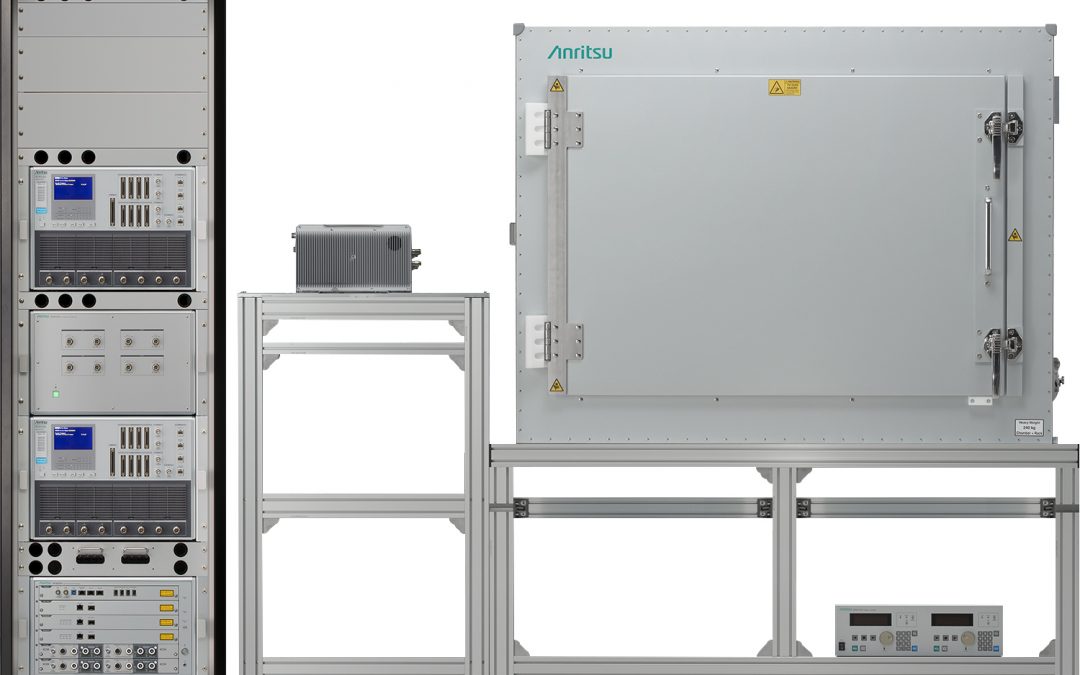
Anritsu, Sony Semiconductor validate industry first Non-Terrestrial Network (NTN) NB-IoT testcase
First NTN NB-IoT Protocol Conformance Tests for have been validated on the 5G NR Mobile Test Device Platform Anritsu Corporation has announced that the first NTN NB-IoT Protocol Conformance Tests for has been validated on the 5G NR Mobile Device Test Platform ME7834NR...
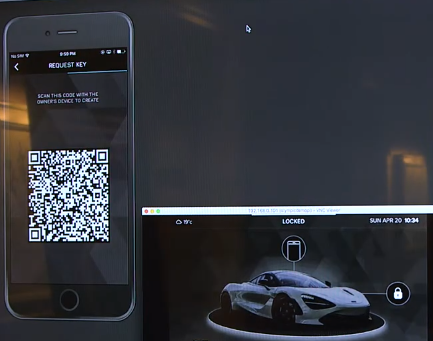
Ellisys Introduces Support for CCC Digital Key Technology
Protocol Updates Aid in Test, Validation, and Debug for Automotive and Consumer Electronics Developers and Test Labs Ellisys, a leading worldwide provider of Bluetooth®, Universal Serial Bus (USB), Ultra-Wideband, and Wi-Fi® protocol test and analysis solutions has...
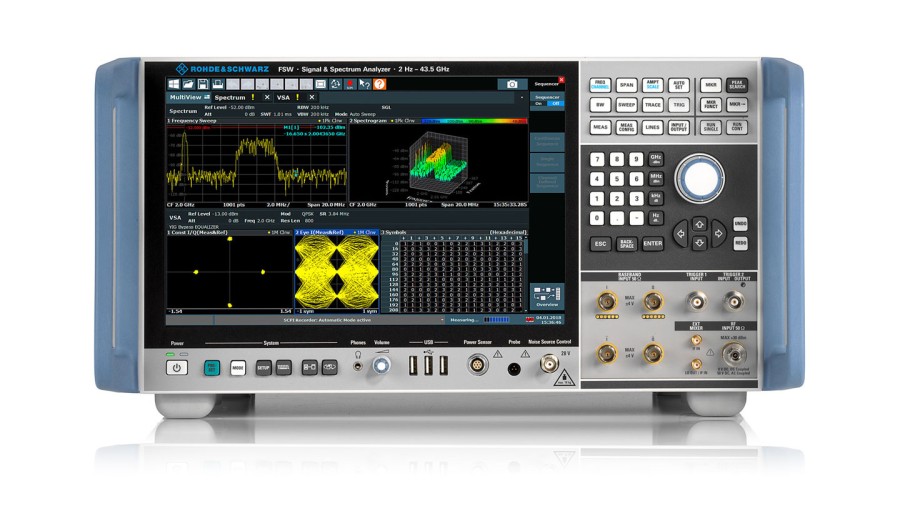
Rohde & Schwarz 170 GHz power sensors ease use and traceability in the D-band
Rohde & Schwarz is launching the new R&S NRP170TWG(N) thermal power sensor for precise power level measurements in the D-band. The new R&S NRP170TWG(N) sensors from Rohde & Schwarz are used in general R&D for 6G mobile communications, novel sub-THz...
Stay Up to Date With The Latest News & Updates
Our Sponsors
Incisor.TV partners with leading organisations in the technology sector.
Follow Us
And stay up to date with our news! We are active across the key social media platforms – please do follow us!





0 Comments